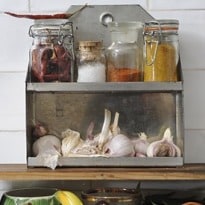Run out of rice? Can't even find freekeh? No problem - there are all sorts of easy ingredient substitutions to make your recipes more flexible - and your shopping lists shorter
Here for store cupboard we'll include fridge, freezer and fruit bowl. With a box of eggs, some milk, lemons, garlic, plus a few other well-chosen fresh, canned and frozen ingredients on hand, the world is your one-pot and much that go with them can be substituted.
Bottles, jars and cans
Capers and olives add salty piquancy and I'm happy to substitute one for the other. I'm all for roasted peppers from jars for sauces and dips, and gherkins pickled with dill add a tartare-like quality to fish dishes, as well as sitting happily with burgers, pate and cheese. Use passata instead of chopped tomatoes, coconut cream instead of coconut milk (dilute with a little water) and substitute frozen for fresh in fish pies or stews. Hot smoked or canned fish is a surprisingly good quick fix flaked into kedgeree, fishcakes or pasta instead of cooking from scratch.
Rice and grains
Delicate basmati and long-grain rice are interchangeable in pilafs, but basmati takes less time to cook. I've made paella with risotto rice and vice-versa. Long-grain rice is best for fried rice leftovers. Switch bulgur wheat for couscous whenever you need, and barley or lentils are good swaps in salads, soups and for thickening stews. Use oats to coat fishcakes before frying if you don't have any breadcrumbs.
Sauces
With good mayo, Worcestershire, a chilli sauce, Tabasco, fish sauce and soy sauce to hand you'll be able to season a world of recipes. Plain yoghurt is great for finishing and mixing with herbs. Thin-shred marmalade adds bite to sauces for want of an orange, and mango chutney makes a delicious glaze when mixed with some mustard.
Oils and vinegar
A good white wine vinegar will see you through most recipes; add sugar to sweeten in place of cider or rice wine vinegar. Peanut, vegetable, sunflower and corn oil are all interchangeable for everyday frying. Save virgin olive oil for dressing, drizzling and flavouring at the end of cooking. Rapeseed oil is an all-round performer that can be substituted for either olive or vegetable (unless you're deep frying). No sesame oil in your larder? Add a sprinkle of toasted sesame seeds at the end of cooking instead.
Nuts and dried fruit
Most nuts can be easily substituted for one another. I'll often use chopped almonds instead of pine nuts, and peanuts instead of cashews in Asian salads. Most dried fruit is swappable - if your tagine needs apricot and you have prunes, no problem.
Pulses
Canned chickpeas are the ultimate pulse, at home in almost any cuisine. All canned beans can be swapped, whether butter, borlotti, or black-eyed. Frozen peas are good for soups and emergency frittatas.
Puy, beluga and green lentils can all be switched, but best save red and yellow lentils for soups and dhal. I'll often roast sausages with red onion and cherry tomatoes then serve with lentils for an easy change to mash.
Spices and dried herbs
If a recipe asks for a spice blend, try to create your own before buying a new pot. Read the ingredients on the pack if you're at the shops - you may already have them at home.
For a mild curry-style spice, combine 1 tsp each ground coriander, cumin and turmeric with ½ tsp chilli and ½ tsp cinnamon. For a quick paste, mix this with 1 tbsp oil, 2 crushed garlic cloves and 1 tbsp tomato puree.
Dried herbs are useful where the herb isn't the hero; oregano for tomato sauces, and thyme for anything meaty. If you're substituting dried for fresh, use 1 tsp of dried herbs for each fresh tbsp, as they are pretty potent.
Put into practice: Keralan aubergines with lentils, cashew and tamarind
Small, egg-shaped aubergines, often available in Indian grocers, are worth seeking out for this dish.
Serves 4
3 large or 8-12 baby aubergines
1 tbsp vegetable oil, plus extra for brushing
2 onions, finely diced
5 garlic cloves, crushed
5cm piece of fresh ginger, diced
2 tsp dried chilli flakes
100g red split lentils (masoor dal), rinsed
½ tsp cumin seeds, roasted and ground
3 tbsp yoghurt
3-4 tbsp tamarind paste
A handful of coriander (cilantro) leaves
3 tbsp cashew nuts, roasted
For the topping (optional)
2 tbsp ghee or clarified butter
1 tbsp mustard seeds
4 dried chillies
1 Preheat the oven to 200C/400F/gas mark 6. Prick the aubergines once or twice, brush with a little oil, and roast in the ovenuntil they aresoft (about 30 minutes for regular aubergines, 15 minutes for theegg-sized ones). Cool for a few minutes.
2 Meanwhile, heat the vegetableoil in a large frying pan and cook the onions until translucent. Add the garlic, ginger and chilli flakes and cook until fragrant, then tip in the lentils and enough water to cover by 5cm. Simmer the lentils for about 20 minutes, until they are soft and creamy, topping up the water if needed. Stir in the cumin and season with salt to taste.
3 Cut large aubergines lengthwise into quarters. For egg-shaped aubergines, hold them by their stalks and make vertical slashes at regular intervals, leaving the base and top intact. Push down on the stalk and the skin will open up like a Chinese lantern. Add the aubergines to the lentils, pushing them down halfway. You can prepare the dish to this stage and reheat later.
4 Dollop with the yoghurt and tamarind - don't stir it in - the idea is to get bursts of different flavours. Sprinkle with coriander and cashews. The topping is optional but it really is the icing on the cake. Just before serving, melt the ghee, and heat the mustard seeds and chillies until they sizzle and pop. Tip on top of the aubergines and eat at once with Indian flatbreads or rice.
Recipe from Pulse, Jenny Chandler (Pavilion). Jane Hornby is the author of What to Cook and How to Cook It (Phaidon). To order a copy £18.49 (RRP £24.95) visit theguardian.com/bookshop or call 0330 333 6846.
Photo: Storecupboard swappables. Photography: Jill Mead for the Guardian







